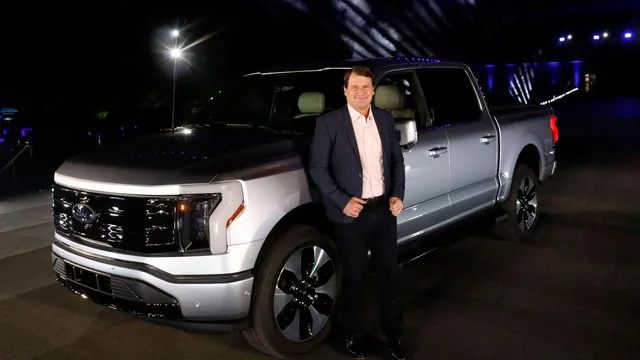
Ford CEO Jim Farley supports LiDAR for self-driving over Tesla's approach
2025-06-28 00:00- Ford CEO Jim Farley advocates for a self-driving approach that includes LiDAR technology, emphasizing its importance for safety.
- In contrast, Tesla CEO Elon Musk supports a cameras-only methodology, arguing against the practicality of LiDAR systems and criticizing their costs.
- This disagreement marks a significant philosophical divide between traditional automotive companies and tech innovators in the autonomous driving sector.
Express your sentiment!
Insights
In a recent discussion at the Aspen Ideas Festival, Jim Farley, the CEO of Ford, stated his preference for Waymo's method of self-driving technology, which integrates LiDAR, cameras, and radar. He emphasized the importance of LiDAR, claiming it functions as a safety net, particularly in situations where camera systems may fail. This contrasts sharply with Elon Musk's firm belief in a cameras-only strategy for Tesla's autonomous vehicles, which include the newly launched Robotaxi service in Austin. Musk criticized Waymo’s technologies for being cost-prohibitive and maintained that Tesla's offerings are far more economically accessible. Farley articulated his concerns regarding the vulnerabilities of a solely camera-based approach and asserted that for a well-known brand like Ford, careful consideration regarding emerging technologies is critical. His remarks reflect a broader industry debate concerning the foundational technologies that should guide the future of autonomous driving. Despite Musk's claims regarding the inadequacies and costs associated with competing technologies such as Waymo's, Farley's statements suggest a growing rift between established automotive manufacturers and tech-focused companies like Tesla. Ford offers BlueCruise, an Advanced Driver Assistance System resembling Tesla's Autopilot but primarily focused on hands-free highway driving. However, BlueCruise and other similar systems developed by competitors like General Motors lack the comprehensive capabilities associated with Tesla's Full-Self Driving, designed to navigate both local streets and highways. Farley's endorsement of LiDAR technology highlights the ongoing discussions about safety in autonomous driving and the necessary trade-offs between cost and technology effectiveness, emphasizing a divergence in philosophy among automotive leaders. The conversation around self-driving technology underscores a significant challenge facing the automotive industry: balancing safety with innovation. With varying opinions on the best strategies for achieving this balance, leaders like Farley and Musk represent opposing viewpoints that may shape the future of transportation. As developments in this field continue, the insights from industry executives will play a crucial role in determining the path forward for automakers and tech companies alike.
Contexts
The advancement of self-driving technologies has led to a significant debate surrounding the efficacy of various sensor systems, primarily LiDAR (Light Detection and Ranging) and cameras. Both technologies are pivotal in the development of autonomous vehicles, with their unique advantages and limitations contributing to differing interpretations of their capabilities. LiDAR uses laser beams to measure distances to objects, creating a precise 3D map of the surroundings. This high-resolution mapping ability allows for exceptional accuracy in identifying obstacles at various distances, regardless of lighting conditions. In contrast, camera systems rely on images taken in real-time to interpret surroundings, utilizing algorithms for object recognition, lane detection, and road sign identification. While cameras provide a relatively low-cost solution, their efficacy can be severely impacted by environmental factors such as poor lighting or inclement weather, which can obscure visibility and hinder performance. The choice between LiDAR and cameras often hinges on their integration and complementary nature rather than a direct competition. Many experts propose that the most effective autonomous systems utilize a fusion of both technologies to leverage their respective strengths. For instance, while LiDAR excels in distance measurement and object tracking, cameras can recognize colors and read signs, providing valuable context that LiDAR cannot ascertain. This multi-sensor approach enhances the reliability and robustness of autonomous driving systems, leading to greater safety and increased performance in diverse driving environments. Additionally, the cost factor cannot be overlooked; LiDAR technology, traditionally viewed as expensive, has seen reductions in cost allowing for broader applications. As production advances and new technologies emerge, the price disparity may continue to diminish, making LiDAR more accessible to developers of self-driving technologies. As vehicle autonomy progresses, real-world deployment metrics have demonstrated varying outcomes based on the sensor technology utilized. For example, companies that employ a combination of sensors often report higher levels of operational reliability in complex urban settings compared to those using only one type of sensor. In contrast, heavier reliance on cameras created instances of failure in environments with challenging lighting, suggesting a need for more comprehensive sensor integration for any scalable autonomous transport solution. Moreover, regulatory bodies and manufacturers must consider not just technological capabilities but also public acceptance and trust in autonomous systems as they integrate more fully into regular traffic. An improvement in AI and machine learning algorithms further enhances camera-based systems, allowing them to analyze visual data more adeptly, bridging some gaps that previously limited their performance. Ultimately, the competition between LiDAR and cameras is not solely about superiority but about understanding how they can coexist to push the boundaries of self-driving capabilities. Ongoing research and development will be crucial as automotive and technology industries align their objectives with safety, efficiency, and sustainability in the pursuit of fully autonomous vehicles. Addressing the intricacies of environment adaptation, as well as the economic implications of these technologies, will play a critical role in determining the future landscape of self-driving cars. With both technologies contributing to progress, the future of autonomous vehicles may lie in the artful integration of multiple technological solutions that ensure optimal performance and safety.